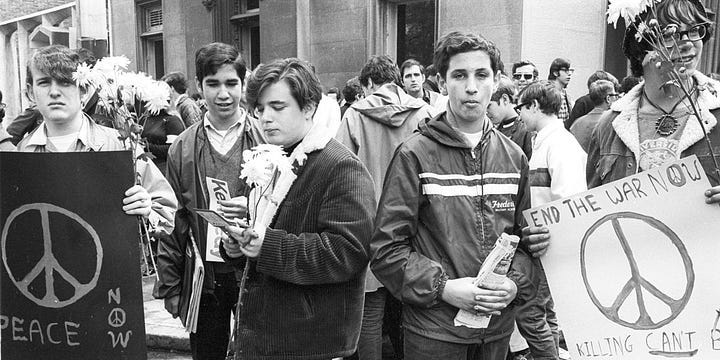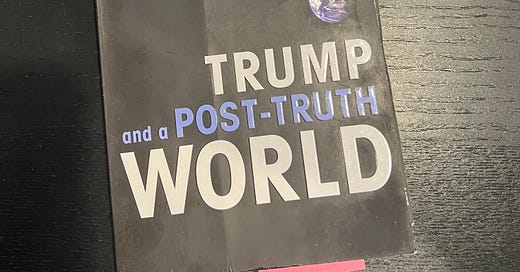A Summary of Ken Wilber's, "Trump and a Post-Truth World"
The Most Important Book No One is Talking About
For many, the election of Donald Trump as the forty-fifth president of the United States in 2016 was a pivotal and shocking moment that raised deep questions about the media, democracy, and even the sanity of otherwise beloved family members.
How did it happen? And is it still happening today? In a world seemingly filled with “fake news,” doesn’t truth matter any more?
Well, Ken Wilber’s book Trump and a Post-Truth World provides as clear an answer to those questions as I’ve found.
Note: This summary includes some complex ideas, which I tried to distill and/or simplify, but I’m not sure how successful I was.
A. The Evolution of Cultural Values
Wilber’s book is not a direct critique of Trump himself (he barely mentions him), but an examination of the broader social and cultural value systems at play within which Trump’s election is far more understandable.
These different value systems are well-researched, though they go by different names, and Wilber simplified his analysis by describing three broad stages of cultural development: “traditional/amber,” “modern/orange,” and, “postmodern/green,” but most often refers to them by colors (see diagram below).
Wilber starts his argument by claiming that the leading-edge of cultural evolution today is green (i.e. post-modern, worldcentric, pluralistic, relativistic, individualistic, diversity/inclusion, human-bond, multicultural, etc.), though roughly 60% of the population operate from the amber (ethnocentric) or below stages. Meaning that if you want to be a counter-culture revolutionary today, the value system you’re pushing against is green (which is roughly 20–25% of the population).

B. The Green, Postmodern World
One of the central postmodernist beliefs Wilber focuses on is that all knowledge is culturally bound; i.e. there is no universally valid perspectives. Thus, all knowledge is based on a mere interpretation, announced and often enforced from a privileged perspective. Given that no culture can be judged against another, what seems like development or evolution throughout history is actually only a story of power and oppression (emphasis on the “only”).
Wilber explains his interpretation of how this postmodern or green worldview carries with it a particularly unhealthy form (though all stages have their unhealthy forms) that is expressed through what he simplifies as, “nihilism and narcissism” (Note: it is the nihilism aspect that is referenced in the title phrase, “POST-TRUTH”). About this, Wilber says…
If there were one line that summaries the message of virtually all of the truly prominent postmodern writers…it is that, ‘there is no truth.’ Truth, rather, was a social construction, and what anybody actually called ‘truth’ was simply what some culture somewhere had managed to convince its members was truth….Even science itself was held to be no more true than poetry (pg. 6).

While postmodernism’s deconstruction of what were considered absolutes (“the myth of the given”) brought with it the discovery of many important insights and practical advances (e.g. civil rights), but like any developmental stage, its perspective is also fundamentally limited (i.e. in Wilber’s words, it’s perspective is “true, but partial”).
At this point, I want to share an extended portion of the book, because it communicates and summarizes Wilber’s perspective fairly clearly. We pick it up right after he explains how orange values (i.e. rationality, science, etc.) had created systems of social existence which, although its own morality is worldcentric, allowed amber/ethnocentric stages to hijack them. Wilber states:
But the postmodern stage — Integral Metatheory’s “green” — brought a 4th-person perspective into significant existence, which had the capacity to reflect on — and critically analyze — these 3rd-person “global” productions, and this is where green postmodernism (so named because it came after, and reflected on, the products of modernism) decided that this rational-modern mentality had, in too many ways, veered off course — both overtly and in deeply counterproductive ways.
And thus came the civil rights movement, the environmental movement (which became larger than any political party anywhere on the planet), emphasis on feelings and “coming from heart” — as opposed to rationality and “coming from the head” (since modern = rational, “postmodern” was often called “post-rational”) — personal and professional feminism, and the sustainability movement (in business and elsewhere) — all of what I have called “the many gifts of green.”

And yet, in the course of its development, driven largely (if often unknowingly) by arcane arguments in academia, the originally healthy pluralistic postmodernism increasingly became an extreme, overblown, self-contradictory, utterly dysfunctional relativism, which, we’ve seen, soon collapsed almost entirely into nihilism and narcissism. It’s the nature of the leading-edge stage that its values, although they are only embraced directly by the stage itself, nonetheless tend to permeate or seep through the culture at large.
For example, when the leading-edge was worldcentric orange rational — whose worldcentric or “all humans treated equally” values inherently included an anti-slavery stance — the Civil War was fought in America in order to end slavery, and over a million white boys (and blacks as well) died in the fight to end black enslavement, yet not much more than 10 percent of the population was actually at the orange stage.
However, that value had seeped throughout the culture of the North, and many were willing to die for it (as many were in the French and American revolutions, which marked an orange democratic overthrow of amber ethnocentric monarchy/aristocracy). The battle, wasn’t black versus white, it was orange versus amber (This “orange versus amber” remains today the central issue in the race wars, as we’ll see).
But this “seepage” of leading-edge values will happen whether the permeating value happens to be really good or not good at all, and a really goofy seepage is what late, dysfunctional, post-truth green gave the world culture.
Namely, there is no truth at all, a post-truth attitude began seeping through the entire culture, and in many ways, it stuck — globally, profoundly, and in a way that caught orange (and healthy green itself) completely off guard (and they still have, basically, no idea where it came from and no idea how to fix it, thanks to a decapitated leading-edge that itself was the actual source of the problem). pg. 22–23.
C. Green’s Resistance to Hierarchy
One of the most obvious places where this limitation shows up is in green’s allergic reaction to the notion of hierarchy. Green often fails to make an important distinction between dominator hierarchies (i.e. more oppressive and power-driven as you go up) and growth hierarchies (also called, “holarchies”), which are frankly, exactly the opposite (i.e. more inclusive and less-oppressive as you go up). A simple example of a growth hierarchy is quarks to atoms to molecules to cells to organism. There is a hierarchy of function, but not control. An organism can’t (and doesn’t try to) control what its atoms do.

A lack of functional distinction-making between the two types of hierarchy, means that extreme green tends to see everything through the lens of oppression and privilege, rather than having that be one of many different lenses it can look through (i.e. “…it’s true, but partial”). Understanding the difference may allow green to integrate relativism (i.e. there are only contexts) with universalism (i.e. but some contexts are universal); which is precisely why the stage beyond postmodern/green is often called, “integral.”
With that said, the deconstruction of truth and power has many benefits, but unfortunately it also often results in what Wilber calls postmodernism’s, “performative contractions.” For example, simultaneously claiming that there is, “no truth,” but also clearly believing that their “no truth”-truth is more true than others’ belief that there is truth. Or saying something like, “We must include all voices!” but then being confounded when a Nazi demands to have their voice heard. (Note: a solution to this scenario could be as simple as using a rule like, “If you do not obey the rules, then you are not protected by the rules.” Meaning, a Nazi can justifiably be excluded from an “embrace everyone’s perspective” kind of discussion if they themselves cannot “embrace everyone’s perspective”).
D. Green’s Arrogant Elitism
Wilber further describes a tendency for the postmodern/green culture to view lower stages (particularly the ethnocentric stage) with an arrogant intolerance. But as Wilber explains, ethnocentric thinking itself (i.e. “Some groups of people are better than others; and it’s usually my group”), is in no way a final destination, but nor is it something that can be eradicated. As a way of thinking, it seems hard-coded into our cognitive structures so that every child born must start fresh on their own developmental journey. Wilber singles out Hillary Clinton’s campaign statement when she called half of Trump supporters, a “basket of deplorables,” a regrettable way to identify a not insignificant portion of the population she was hoping to lead.

This form of name-calling suggested elitism, which is in some ways just an updated form of ethnocentrism, itself predictable, but what makes it particularly annoying is that its proponents will simultaneously (and often aggressively) deny they hold such beliefs. With extreme green, it is the lack of acknowledgement and ownership that makes their beliefs particularly resilient to self-correction (i.e. an example of the “narcissism” of this stage).
Without a clear sense of hierarchy or truth, extreme green often lacks the ability to properly diagnose problems or deploy effective societal solutions. One manifestation of green’s failure as a leading edge of culture is how over the past few decades those in the top 1% are making a fortune while most of the rest of the population economically stagnates or loses ground. Wilber says, “Everywhere you are told that you are fully equal and deserve immediate and complete empowerment, yet everywhere are denied the means to actually achieve it. You suffocate, you suffer, and you get very, very, mad” (pg. 42). Wilber connects this to some research that showed 60% of respondents who identified as, “mad” voted for Trump.

However, green’s relativism-gone-mad (occasionally referred to as, “the mean green meme,” or, “Boomeritis”), as Wilber describes it, cannot be properly understood in isolation. While it is a problem to be explored in great depth and detail, the bigger issue is that even when green is manifesting in its healthy forms, it’s surrounded by the roughly 60% of society who do not share that worldview! It is inherently in conflict between the amber, orange, and green values that are more properly associated with the term, “Culture Wars,” not right vs. left, or conservative vs. liberal.
E. So, Why Was Trump Elected in 2016?
Candidate Trump (and then President Trump) famously used the term, “fake news” to disrupt how the media and the wider public interpreted what was real. Progressive institutions (academic and news media in particular) that had previously attacked the foundations of capitalism, hierarchy, and, “truth,” suddenly found themselves having to contend with relativism reflected back at them. Suddenly, truth really mattered. But most didn’t (and still haven’t) figured out how to integrate those values.
Wilber acknowledges the role of technology and the media in the spread of disinformation and extremist views, which have only furthered partisan entrenchment, and help enable Trump’s rise. As an example, Wilber mentions Google’s search algorithm which rewards extreme views, as well as the social media ecosystem in which people who were historically only consumers of news and information are now involved in the production and spread of it.

With all of that said, this brings us to a rather abrupt answer to Wilber’s initial question, “Why was Donald Trump elected?” Wilber attempts to add to our understanding by deducing that Trump was elected because; 1) enough people had lost faith in green’s ability to lead (represented by Hillary Clinton), and/or 2) enough people, whether they were traditionalists (amber), modernists (orange), or even post-post modernists (teal), all shared one thing: they were anti-green. And Trump’s politics and style were anything but green.
With that said, Wilber suggests Trump’s political success was likely not due to a strategic exploitation of socio-cultural dynamics, but rather stemmed from his narcissistic traits and an intuitive sense of the public’s discontent with green.
F. Finally, What Can We Do About It?
Wilber’s answer to the question, “what can we do about it” at least broadly, involves using the perspective of stages beyond postmodern/green (i.e. integral/teal), since higher stages transcend and include the values and distinctions of previous stages, to inform the action of the failing leading-edge green culture. For more on what “teal” looks like see this.
Additionally, Wilber prescribes two (very) broad agenda items green can do to help disentangle itself from its own knots: 1) drop its reactive hatred and hostility to all previous value levels; 2) adopt and accept growth hierarchies, which inherently combat dominator hierarchies.
To these, I will add what Wilber implies but never says explicitly: learn more about integral theory. In addition to evolutionary stages, integral theory also includes a quadrant model of perspectives (see image below), which by itself helps untangle the nature of “truth,” by pointing to the fact that the way we define and validate truth in the sciences (Right-side, objective, material, exteriors, etc.) is different than how we define and validate the truth in spiritual practice (Upper Left, subjective, mental, interiors, etc.), and even how we define and validate ethical/moral truth (Lower Left, culture, language, etc.).
Conclusion
In many ways, I interpret the question of why Trump was elected was just a framework through which Wilber could explain and apply the field of socio-cultural evolution, not a specific question that he felt the need to categorically satisfy.
Wilber’s book isn’t based on new research. By his own admission as an academic, the book is more like an expanded op-ed piece, not a scholarly and detailed analysis of the psychological, political, or economic factors.
His book also isn’t packed full of practical recommendations. In fact, my only critique, which I found myself writing over and over again in the margins was, “Yes, but how!?” Maybe, “critique” is the wrong word, but it definitely left me hungry to explore the implications more concretely (something I plan to do in a follow-up post).
According to Wilber, we are living a post-truth world. And no matter what happens with Donald Trump in the next few years, I believe one thing is clear: if you care about the truth, you’re going to have to fight for it because, for a significant percentage of the population, the nature of truth itself is no longer self-evident.






